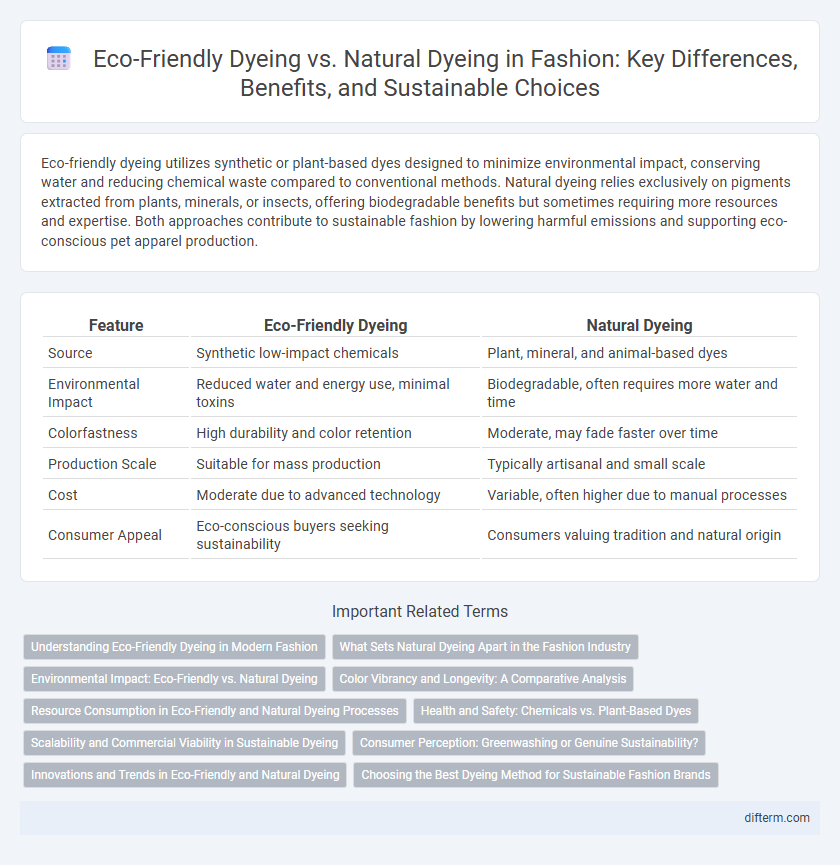Eco-friendly dyeing utilizes synthetic or plant-based dyes designed to minimize environmental impact, conserving water and reducing chemical waste compared to conventional methods. Natural dyeing relies exclusively on pigments extracted from plants, minerals, or insects, offering biodegradable benefits but sometimes requiring more resources and expertise. Both approaches contribute to sustainable fashion by lowering harmful emissions and supporting eco-conscious pet apparel production.
Table of Comparison
| Feature | Eco-Friendly Dyeing | Natural Dyeing |
|---|---|---|
| Source | Synthetic low-impact chemicals | Plant, mineral, and animal-based dyes |
| Environmental Impact | Reduced water and energy use, minimal toxins | Biodegradable, often requires more water and time |
| Colorfastness | High durability and color retention | Moderate, may fade faster over time |
| Production Scale | Suitable for mass production | Typically artisanal and small scale |
| Cost | Moderate due to advanced technology | Variable, often higher due to manual processes |
| Consumer Appeal | Eco-conscious buyers seeking sustainability | Consumers valuing tradition and natural origin |
Understanding Eco-Friendly Dyeing in Modern Fashion
Eco-friendly dyeing in modern fashion employs innovative technologies and sustainable chemicals to reduce water usage and toxic waste, setting it apart from traditional natural dyeing that relies solely on plant-based materials. This method enhances colorfastness and consistency while minimizing environmental impact, making it a preferred choice for scalable manufacturing. Brands adopting eco-friendly dyeing techniques contribute significantly to lowering the fashion industry's carbon footprint and promoting circular economy practices.
What Sets Natural Dyeing Apart in the Fashion Industry
Natural dyeing in fashion distinguishes itself through the use of plant-based, mineral, and insect-derived pigments, ensuring a biodegradable and non-toxic alternative to synthetic chemicals. Unlike eco-friendly dyeing methods that may still incorporate low-impact synthetic processes, natural dyeing emphasizes traditional, sustainable techniques that minimize environmental harm and support biodiversity. This approach also offers unique color variations and cultural heritage preservation, setting it apart as an artisanal and environmentally responsible practice.
Environmental Impact: Eco-Friendly vs. Natural Dyeing
Eco-friendly dyeing methods significantly reduce water pollution and chemical waste compared to traditional processes, utilizing low-impact synthetic dyes and advanced wastewater treatment technologies. Natural dyeing uses plant-based or mineral dyes, offering biodegradability but often requires large quantities of water and raw materials, potentially leading to resource depletion. Sustainable fashion prioritizes eco-friendly dyeing techniques for scalable environmental benefits, while natural dyes cater to artisanal and niche markets with minimal synthetic chemical exposure.
Color Vibrancy and Longevity: A Comparative Analysis
Eco-friendly dyeing techniques often utilize synthetic alternatives designed to reduce environmental impact while maintaining color vibrancy, though they may sometimes fall short in achieving the rich hues characteristic of natural dyes derived from plants and minerals. Natural dyeing offers deep, earthy tones and enhanced longevity due to the inherent properties of organic pigments binding well to natural fibers, yet it can face challenges in color consistency and fastness under prolonged sunlight exposure. Comparative studies reveal that while eco-friendly synthetic dyes provide greater uniformity and quicker processing, natural dyes excel in producing unique, lasting colors that improve with age, appealing strongly to sustainable fashion markets.
Resource Consumption in Eco-Friendly and Natural Dyeing Processes
Eco-friendly dyeing processes minimize water and energy consumption by utilizing advanced low-impact chemicals and closed-loop systems that recycle effluents. Natural dyeing relies on plant-based pigments but often requires large quantities of water and raw materials, increasing overall resource usage. Innovations in eco-friendly dyeing offer significant reductions in carbon footprint and wastewater compared to traditional natural dyeing methods.
Health and Safety: Chemicals vs. Plant-Based Dyes
Eco-friendly dyeing reduces the use of harmful chemicals, minimizing health risks for workers and consumers, while natural dyeing uses plant-based dyes that are non-toxic and biodegradable. Chemical dyes often contain heavy metals and synthetic compounds that can cause skin irritations and environmental pollution. Plant-based dyes promote safer production environments by avoiding hazardous substances and supporting sustainable fashion practices.
Scalability and Commercial Viability in Sustainable Dyeing
Eco-friendly dyeing methods utilize synthetic but non-toxic dyes designed for large-scale textile production, offering consistent color output and compatibility with industrial machinery, which enhances commercial viability. Natural dyeing relies on plant, mineral, or insect-based pigments, providing biodegradable and low-toxicity options but faces challenges in scalability due to variability in colorfastness and supply limitations. Integrating eco-friendly synthetic dyes with improved environmental profiles presents a more feasible pathway for large-scale sustainable dyeing in the fashion industry compared to exclusively natural dye sources.
Consumer Perception: Greenwashing or Genuine Sustainability?
Consumer perception of eco-friendly dyeing techniques often hinges on distinguishing genuine sustainability from greenwashing, where brands may exaggerate environmental benefits without transparent practices. Natural dyeing, praised for its use of renewable resources and minimal chemical impact, tends to be viewed more favorably but faces scrutiny regarding scalability and colorfastness. Brands that provide clear certifications and traceability reports typically earn higher trust, positively influencing consumer loyalty and willingness to pay a premium for truly sustainable fashion.
Innovations and Trends in Eco-Friendly and Natural Dyeing
Innovations in eco-friendly dyeing focus on reducing water usage, utilizing low-impact synthetic dyes, and incorporating biodegradable chemicals to minimize environmental harm. Advances in natural dyeing techniques leverage plant-based and microbial pigments, enhancing color fastness and expanding the palette with sustainable sources like indigo and madder root. Current trends emphasize closed-loop processes, digital color matching, and collaborations between biotech startups and fashion brands to create scalable, eco-conscious dyeing solutions.
Choosing the Best Dyeing Method for Sustainable Fashion Brands
Eco-friendly dyeing utilizes low-impact synthetic or plant-based dyes that reduce water consumption and chemical waste, aligning with sustainability goals for fashion brands. Natural dyeing relies on organic materials like indigo, madder, and turmeric, offering biodegradable and non-toxic colorants but often requires more resources and longer processing times. Sustainable fashion brands must balance environmental impact, scalability, and fabric compatibility when choosing between eco-friendly and natural dyeing methods to optimize their green initiatives.
eco-friendly dyeing vs natural dyeing Infographic

 difterm.com
difterm.com